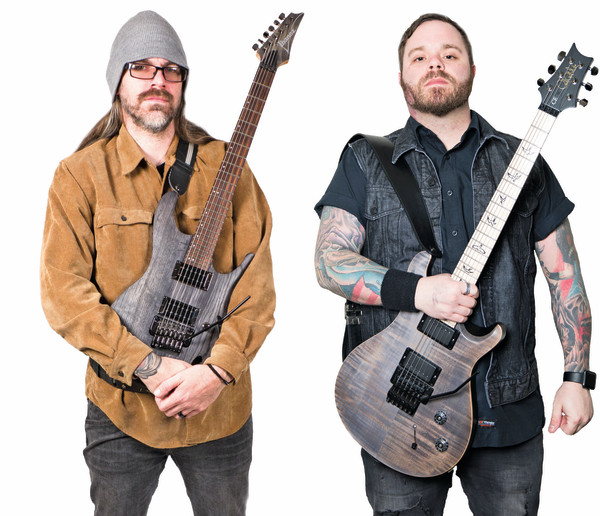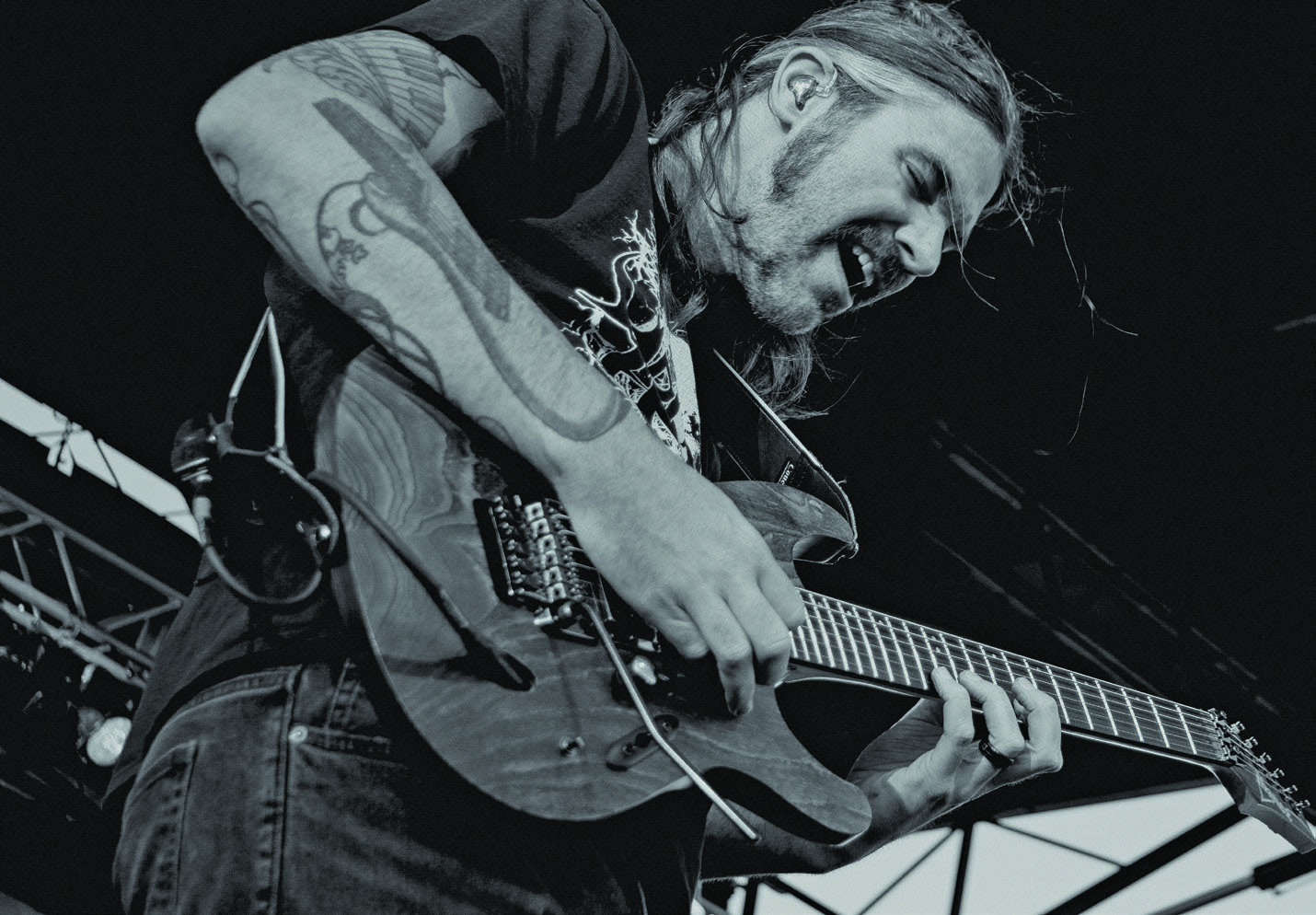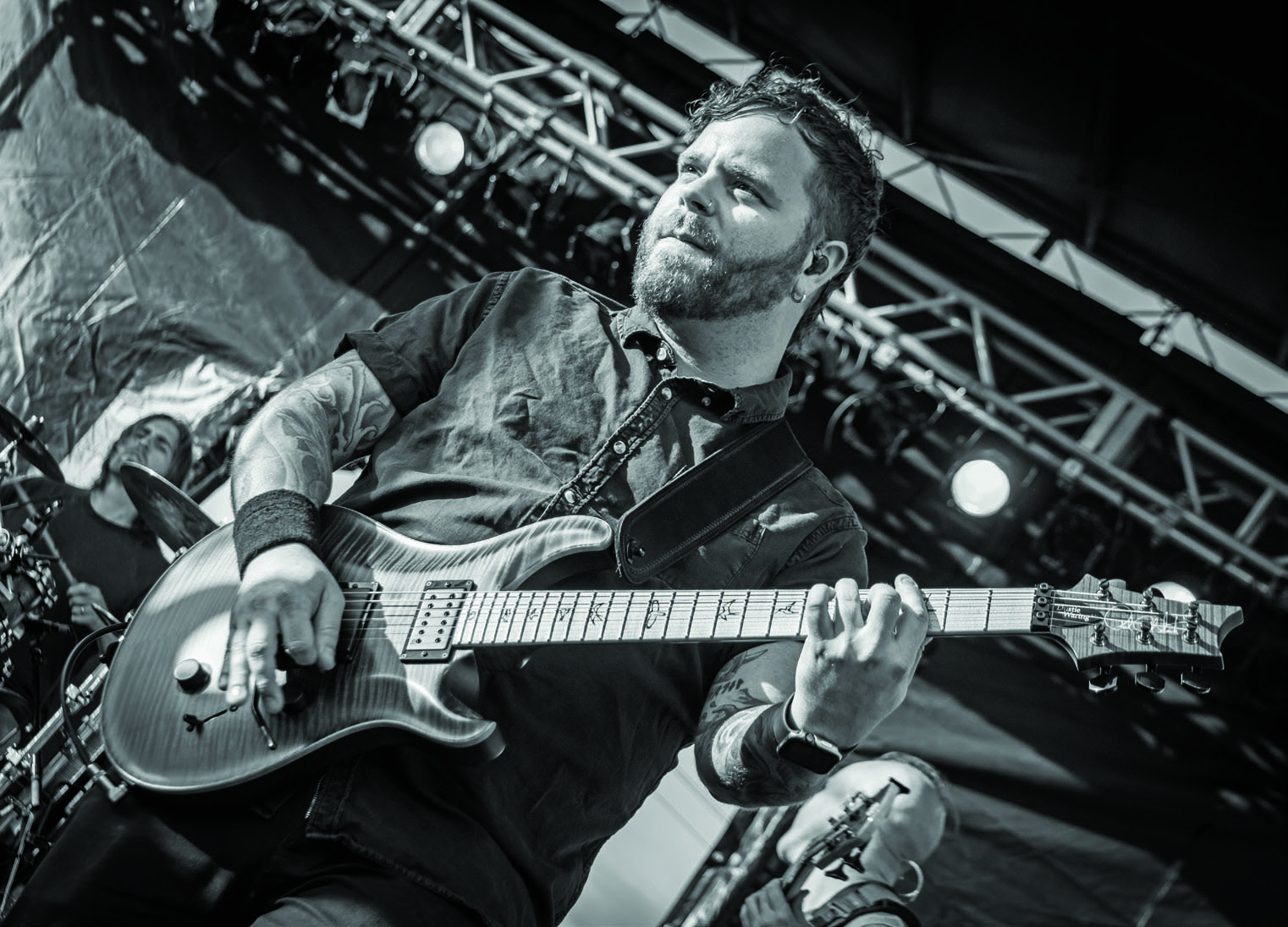Between the Buried and Me's Dustie Waring and Paul Waggoner Break Down Their Sprawling, Multi-Part 'Automata'

Never let it be said that the members of North Carolina progressive metal outfit Between the Buried and Me aren’t fully committed to mathy complexity, even when they’re far away from the studio or the stage. To wit, when Guitar World catches up with guitarists Dustie Waring and Paul Waggoner, the latter proudly proclaims that he’s currently “at home, installing some weird thing on my garage door so I can open it using my phone.” Waggoner laughs. “We’re getting very techy over here!”
The band, it’s worth noting, is also getting pretty techy in their music. Between the Buried and Me—which also includes singer and keyboardist Tommy Giles Rogers, Jr., drummer Blake Richardson and bassist Dan Briggs—have been one of the more experimental and expansive units in metal for close to two decades now. But in the past few years they’ve been pushing ever further out on their prog tendencies—first with the conceptual one-two punch of the 2011 EP The Parallax: Hypersleep Dialogues and its 2012 full-length follow-up, The Parallax II: Future Sequence, and then with 2015’s spiritual time-travel epic, Coma Ecliptic.
Now, the band is releasing their eighth full-length—or, make that, their eighth and ninth full-lengths—Automata, a conceptual effort that will be issued in two parts. The music, as always, is stunningly complex and technically dazzling—the six-track Automata I begins with the crushing and shapeshifting “Condemned to the Gallows,” peaks with the unusually melodic and textured “Millions” and wraps with the 10-minute-plus prog-pomp-psych epic “Blot,” while Automata II, scheduled for release this summer, is highlighted by a kaleidoscopic, almost carnival-esque romp titled “Voice of Trespass.” The story told in the two albums’ lyrics is similarly mindbending, focused on, in Waggoner’s words, “this idea that, in the future, entertainment has sort of devolved to a point where we’re actually tapping into people’s brains and broadcasting their dreams.”
It’s a lot to take in, for sure, which explains why the band decided to break the music into two separate releases. Says Waggoner, “I don’t know about Dustie, but speaking for myself, sometimes it’s hard for me to digest all our music in the creation process. So I can’t imagine what it’s like for someone who has literally never heard the songs to listen to them from the ground up. But when we all put our brains together we just end up with songs and albums that are…let’s just say there’s a lot going on.”
Waring concurs. “I don’t think we’ve ever gone into a record saying, ‘Hey, we should make this one weird.’ ” He laughs. “But then every record, the material that everyone writes just ends up being stranger and stranger. But that’s just the way we like it.”
Waring and Waggoner recently sat down with Guitar World to discuss the making of Automata, their feelings on the new crop of tech-heavy, shred-happy bands, and how recording acoustic guitars turns one of them into a hot, sweaty—and angry—mess.

One thing that is readily apparent is that Automata is an overall heavier record than Coma Ecliptic.
Get The Pick Newsletter
All the latest guitar news, interviews, lessons, reviews, deals and more, direct to your inbox!
PAUL WAGGONER That was pretty intentional. In the writing process it just seemed like people were writing heavier stuff. Heavy and dark. So I think that was something that very early on we were like, “This album is gonna be a lot heavier than the last one.” It’s a lot more riff-centric, and the guitar is more the showcase piece. Whereas on Coma Ecliptic the approach from a guitar standpoint was more of a sort of orchestration with the other instruments. This album is more riffs. And we wanted to start the record off with a heavy song, which we do with “Condemned to the Gallows.”
Then there’s a song like “Millions,” which is super melodic, with a lot of clean instrumentation and vocals.
DUSTIE WARING That was an idea that I had probably a year ago. I really love Alice in Chains and Jerry Cantrell, and sometimes I find myself playing along to stuff like that and just focusing on how good his riffs are. And then one day I was messing around with some tunings and came up with that idea and sent it to the guys. It’s something pretty different for us, and we’re always excited to do something that’s not the norm. It’s almost like our take on a heavy Nineties song.
At the same time, Automata makes it clear you’re still in a pretty proggy place.
WARING Yeah. I moved to Nashville in September, and being out here and interacting with different musicians that are predominantly playing three-minute songs that are, like, commercial music, it’s funny sometimes. When I show them our music, it doesn’t always go over that well. People are like, “What the hell’s going on? Is that song really 15 minutes long?” Yeah…it is. [laughs]
What gear did you use on the new record?
WARING This time around, for all the rhythms we used the first head that my dad bought me back when I was about 15—an original Peavey 5150. I ended up selling it to [Automata producer] Jaime King, who had it modded, and it kinda beat out anything else we tried. We also had one of the new Port City Soulstice heads, which was killer.
WAGGONER We used that for some of the mid-gain, slightly dirty sounds.
WARING We also used [Periphery guitarist] Misha Mansoor’s new Horizon Precision Drive for pretty much all the dirty tones. That’s a nice pedal. Then for guitars, Paul had his signature [PWM] Ibanez with his signature Mojotone [PW Hornet] pickups. And I had my signature PRS [the new DW CE 24 "Floyd"] with my signature Mojotone [DW Tomahawk] pickups. We also used a Custom Shop Telecaster, a banjitar, a 12-string Taylor, a PRS Private Stock Angelus acoustic…we used all kinds of stuff.
The first song on the record, “Condemned to the Gallows,” starts off with acoustic guitar. Paul, I recall in the past you saying you find recording acoustics to be a pain.
WAGGONER Oh, goddammit, I fucking hate it! It’s terrible.
WARING [laughs] We always have great bloopers of Paul recording acoustics.
WAGGONER You could probably make an album of me just throwing expletives out there constantly when I record acoustics. I can’t stand it. I don’t like to make excuses, but a lot of it is that we tune down to C sharp standard, and acoustic guitars are really not meant to be tuned that way. And the parts are not the craziest parts in the world, but they require a certain precision—when you get any fret buzz or anything like that they sound like shit. So I’ll be in the studio just doing take after take after take. Another thing is we record the acoustic in a vocal booth, and it’s hot as fuck in there. So sometimes I have to take my shirt off…it’s just a mess. [laughs] But this time it actually went pretty smoothly. It wasn’t as bad as it normally is.

These days there are lot of technical, shred-heavy bands out there. But you guys have a definite classic feel to your music, with a lot of Seventies prog influence, that seems to be absent from many of your peers. Do you feel like you come to the genre from a bit of a different angle?
WARING I think so. A lot of the bands that are out there doing crazy stuff, they’re really young guys, man. We’ve toured with bands like Chon and Polyphia, and these guys are young and just killer players. But I think the difference in the way we sound is because of the music we listen to. Dan, for one, listens to, like, all the same music that my uncle listens to. [laughs] And Paul and I listen to Alison Krauss. Everyone listens to all kinds of shit that you wouldn’t expect. So maybe it’s just what’s going in our ears.
WAGGONER I also think they just learned guitar in a very different way than I learned guitar. I learned on Nineties grunge and alternative music. I learned Smashing Pumpkins songs. This new generation of kids, they were learning maybe Allan Holdsworth and stuff like that. Plus, they had the internet. So I think there was a time where players like Dustie and I were considered shredders, but now there’s this whole new generation of dudes who play circles around us. I don’t even know what they’re doing. [laughs] Guys like Tosin Abasi or, like Dustie says, the Chon guys. These kids are just playing insane stuff.
You tour with acts like Chon and Polyphia, but then you’ll also play shows with more straightforward metal bands like Mastodon. Does one scene feel more comfortable to you than the other?
WARING Personally, I feel more at home with bands like Mastodon, who are focused more on riffing and soloing in a classicrock way. Because, shit, we’re getting old now, man! Neither one of us has time to sit around and play to a metronome. [laughs] So I don’t think either one of us for a long time now has really cared about impressing anyone with shred or anything like that. We’d both rather do something tasteful and that’s better for the song than go jerk off and write 2,400 notes, you know what I mean?
WAGGONER In a lot of ways this newer crop of shredders has made me realize what it is I enjoy about guitar, and it’s made me revert back to the original reason I play guitar. Which is that I just like riffs. I like pentatonic scales. I like classic rock. I’ve gone back into that world again and I’ve been able to kind of fuse that with the style I’ve developed over the years. I’m no longer trying to keep up with these other guitar players. I have no interest in playing that fast. I have no interest in learning new techniques. I just want to do what I do. But I want to do it better and in a way that’s more authentic.
Is that a big change from how you and Dustie used to approach things in Between the Buried and Me?
WAGGONER Well, I’ll say this: A lot of times when we have to relearn old songs for a tour, dude, I have a hard time playing some of that shit! First off, I’m like, “I can’t believe I wrote that! What was I thinking?” And then secondly I’ll think, I can’t believe I could ever play this cleanly! So now my goal is just to write music that I’ll be able to play comfortably in 10 years. I’m almost 40—it gets hard to play this shit! [laughs] I don’t want performing music to be stressful. I want it to be fun. And that’s the bottom line with us. We just try not to take ourselves too seriously. Our theory is, if it’s cool, it’s cool. There are no rules.
Rich is the co-author of the best-selling Nöthin' But a Good Time: The Uncensored History of the '80s Hard Rock Explosion. He is also a recording and performing musician, and a former editor of Guitar World magazine and executive editor of Guitar Aficionado magazine. He has authored several additional books, among them Kurt Cobain: Montage of Heck, the companion to the documentary of the same name.










